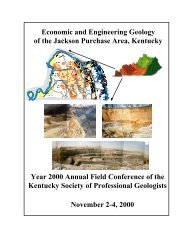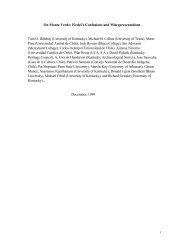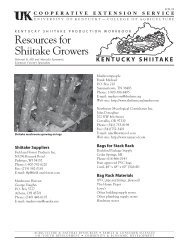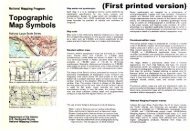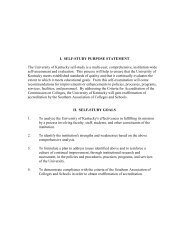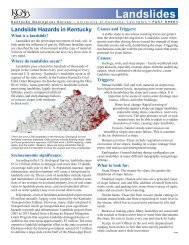GEOLOGIC FEATURES RELEVANT TO GROUND-WATER FLOW ...
GEOLOGIC FEATURES RELEVANT TO GROUND-WATER FLOW ...
GEOLOGIC FEATURES RELEVANT TO GROUND-WATER FLOW ...
Create successful ePaper yourself
Turn your PDF publications into a flip-book with our unique Google optimized e-Paper software.
6 Kentucky Geological Survey Open-File Report OF-97-02<br />
notes. A rose diagram was prepared for this study using<br />
the orientations of all dikes described on the Elva, Oak<br />
Level, Paducah West, and Heath geologic quadrangle<br />
maps (288 individual measurements) (Fig. 10). The many<br />
measurements make these data particularly significant.<br />
The primary trend among the clastic dikes is northeastward,<br />
and the secondary trend is northwestward (normal<br />
to the primary trend). The coincidence of the primary<br />
trend of the clastic dikes and the direction of faulting in<br />
the plant area probably reflects that the faults and dikes<br />
formed under similar stress conditions.<br />
If a sufficient number of clastic dikes are present in the<br />
vicinity of the plant, they may exert a significant control<br />
on ground-water flow in the area. However, because the<br />
Porters Creek Clay is not well exposed in the Paducah<br />
area, the density of these features cannot be accurately<br />
assessed.<br />
LINEAMENTS<br />
As part of this initial study, photographic and digital<br />
imagery available to the Kentucky Geological Survey was<br />
assessed for use in the project, particularly as a means of<br />
suggesting areas of potential faulting and extensive fracturing<br />
(i.e., lineament studies). Only data in KGS files and<br />
some data easily obtainable from the Illinois State Geological<br />
Survey were considered. Most of the data available<br />
at KGS consisted of 1:1,000,000- and 1:500,000-<br />
scale Landsat satellite imagery for the Paducah area. Because<br />
of the small scale, this imagery was only very generally<br />
examined, and was not considered appropriate for<br />
lineament studies. Because of the lack of funding for remotely<br />
sensed data in this project, other potentially available,<br />
but expensive products were not considered for purchase.<br />
A SLAR image mosaic for the Paducah area was made<br />
available for study by the Illinois State Geological Survey.<br />
The mosaic includes the Paducah 30 x 60 minute area<br />
covered by the conventional U.S. Geological Survey map<br />
and is at a scale of 1:250,000. The image was produced by<br />
the SAR system and is west-looking, X-band, near-range<br />
synthetic-aperture radar data printed as a photographic<br />
mosaic by the U.S. Geological Survey. The imagery was<br />
produced by Aero Service Division, Western Geophysical<br />
Company of America, from data flown during November<br />
1984 at 30,000 ft above mean sea level. Part of the mosaic<br />
used in the analysis is shown here as Figure 1 and represents<br />
the area in the vicinity of the plant and to its east and<br />
north.<br />
The study area was examined for lineaments that might<br />
represent faults or fractures important to understanding<br />
the ground-water flow system of the area. This examination<br />
was made using the unenhanced photographic version<br />
of the data. The examination was made by eye, looking at<br />
low angles along approximate northeast and southwest<br />
directions on the photograph. Linear features were drawn<br />
by fine-point pen on a Mylar overlay and transferred to a<br />
1:250,000-scale base map using landmarks such as the<br />
configuration of the Ohio River as registration points.<br />
This procedure revealed many northeast-oriented<br />
lineaments, some of which correspond to mapped faults,<br />
but all of which are parallel or subparallel to the structural<br />
grain of the area (compare Plates 1 and 2). The lineaments<br />
in the vicinity of the plant site were transferred onto a<br />
larger scale map (Fig. 2). The placement of the lineaments<br />
on Figure 2 is not highly accurate, however, because of<br />
the vast difference in scale between the lineaments interpreted<br />
on the 1:250,000-scale mosaic and the roughly<br />
1:45,000-scale of Figure 2. More accurate lineament<br />
mapping is beyond the scope of this study.<br />
The results of this preliminary lineament study, however,<br />
are encouraging. Several lineaments have been interpreted<br />
in the vicinity of the plant that are oriented<br />
N45°E. All of the lineaments are subparallel to the two<br />
northeast-oriented Tc99 and TCE ground-water pollution<br />
plumes shown on Figure 2. The lineaments form an angle<br />
of about 35° with the clastic dike mapped by Olive (1966a–<br />
b).<br />
One of the prominent northeast-oriented lineaments is<br />
closely coincident with the northwest contaminant plume<br />
and is centered on a major fault zone interpreted by Ron<br />
Street of the UK Department of Geological Sciences<br />
(written communication, 1997) from a six-fold seismicreflection<br />
profile run along a part of State Highway 385<br />
north of the plant site. The lineament extends southwest of<br />
the plant site, as well as northwest to the Ohio River. It is<br />
unknown north of the river. The lineament is subparallel<br />
to a short road segment, but extends to the southwest and<br />
northeast beyond the extent of the road. Another fault<br />
zone detected by Street to the northwest along the road<br />
does not correspond to a lineament detected in this study.<br />
These results suggest that further lineament studies<br />
with higher resolution, larger scale, remotely sensed data<br />
could be a fruitful avenue for future research.<br />
CONCLUSIONS<br />
In all likelihood, the plant area is traversed by the<br />
Fluorspar Area Fault Complex, and is therefore underlain<br />
by a series of northeast-trending faults. These structures<br />
are predominantly obscured by Cretaceous and younger<br />
sediments of the Mississippi Embayment, but a few northeast-trending<br />
structures have been mapped in the Paducah<br />
area (Plate 3). The number of modern-day earthquakes<br />
reported in the area indicates that these structures remain






